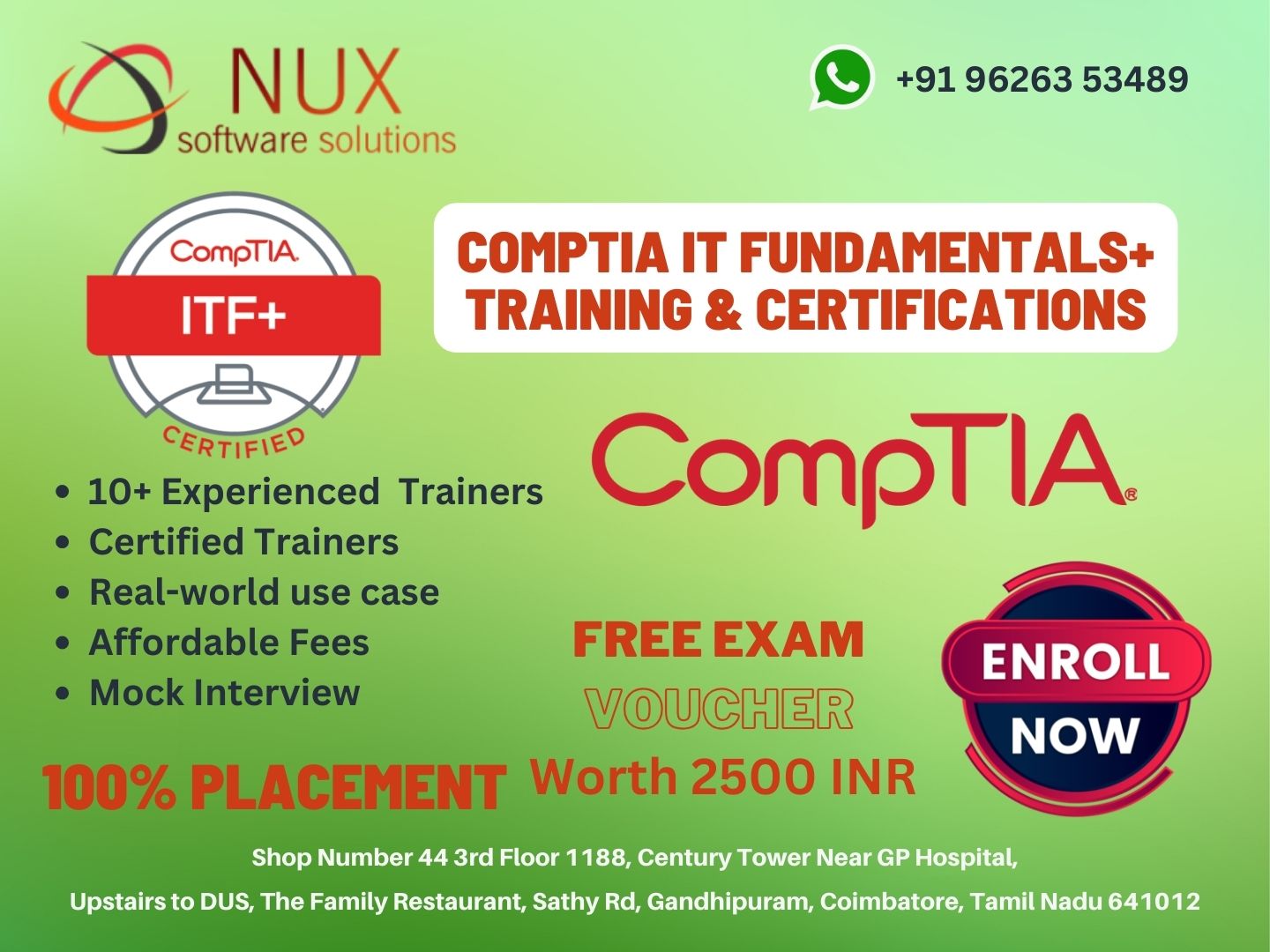CompTIA Data+ DA0-001


NuxSoftware Training & Certification Solutions in Coimbatore is doing a commendable job in providing top-notch training programs, especially for CompTIA Data+ (DA0-001). The combination of an excellent training center environment, advanced labs infrastructure, and international expert trainers with real-time industry experience makes it an ideal choice for individuals seeking to enhance their skills in data-related domains.
The emphasis on performance-based items in the CompTIA Data+ (DA0-001) certification adds a practical and hands-on aspect to the evaluation process. This approach ensures that professionals are not only equipped with theoretical knowledge but also have the ability to apply their skills in real-world scenarios. This makes the certification a valuable and practical validation of one’s capabilities in data-related roles.
The adaptability of CompTIA certifications, including their regular reinvention by IT experts, ensures that they stay relevant and aligned with the evolving demands of the IT industry. This commitment to staying current and addressing the core skills and abilities required in end point management and technical support roles makes CompTIA certifications trusted indicators of a professional’s competence in these areas.
Course Syllabus
CompTIA Data+ DA0-001 Syllabus
Chapters
Data Concepts and Environments - 15%
- Databases
Relational
Non-relational
- Data mart/data warehousing/data lake
Online transactional processing (OLTP)
Online analytical processing (OLAP)
- Schema concepts
Snowflake
Star
- Slowly changing dimensions
Keep current information
Keep historical and current information
- Date, - Numeric, - Alphanumeric, - Currency, - Text, - Discrete vs. continuous, - Categorical/dimension, - Images, - Audio, - Video,
- Structures
Structured
- Defined rows/columns
- Key value pairs
Unstructured
- Undefined fields
- Machine data
- Data file formats
Text/Flat file
- Tab delimited
- Comma delimited
JavaScript Object Notation (JSON)
Extensible Markup Language (XML)
Hypertext Markup Language (HTML)
Data Mining - 25%
- Integration, Extract, transform, load (ETL), Extract, load, transform (ELT), Delta load, Application programming interfaces (APIs), - Data collection methods, Web scraping, Public databases, Application programming interface (API)/web services, Survey, Sampling, Observation,
- Duplicate data
- Redundant data
- Missing values
- Invalid data
- Non-parametric data
- Data outliers
- Specification mismatch
- Data type validation
- Recoding data
Numeric
Categorical
- Derived variables
- Data merge
- Data blending
- Concatenation
- Data append
- Imputation
- Reduction/aggregation
- Transpose
- Normalize data
- Parsing/string manipulation
- Data manipulation
Filtering
Sorting
Date functions
Logical functions
Aggregate functions
System functions
- Query optimization
Parametrization
Indexing
Temporary table in the query set
Subset of records
Execution plan
Data Analysis - 23%
- Measures of central tendency
Mean
Median
Mode
- Measures of dispersion
Range
Max
Min
Distribution
Variance
Standard deviation
- Frequencies/percentages
- Percent change
- Percent difference
- Confidence intervals
- t-tests
- Z-score
- p-values
- Chi-squared
- Hypothesis testing
Type I error
Type II error
- Simple linear regression
- Correlation
- Process to determine type of analysis
Review/refine business questions
Determine data needs and sources to perform analysis
Scoping/gap analysis
- Type of analysis
Trend analysis
- Comparison of data over time
Performance analysis
- Tracking measurements against defined goals
- Basic projections to achieve goals
Exploratory data analysis
- Use of descriptive statistics to determine observations
Link analysis
- Connection of data points or pathway
- Structured Query Language (SQL)
- Python
- Microsoft Excel
- R
- Rapid mining
- IBM Cognos
- IBM SPSS Modeler
- IBM SPSS
- SAS
- Tableau
- Power BI
- Qlik
- MicroStrategy
- BusinessObjects
- Apex
- Dataroma
- Domo
- AWS QuickSight
- Stata
- Minitab
Visualization - 23%
- Data content
- Filtering
- Views
- Date range
- Frequency
- Audience for report
Distribution list
- Report cover page
Instructions
Summary
- Observations and insights
- Design elements
Color schemes
Layout
Font size and style
Key chart elements
- Titles
- Labels
- Legends
Corporate reporting standards/style guide
- Branding
- Color codes
- Logos/trademarks
- Watermark
- Documentation elements
Version number
Reference data sources
Reference dates
- Report run date
- Data refresh date
- Frequently asked questions (FAQs)
- Appendix
- Dashboard considerations
Data sources and attributes
- Field definitions
- Dimensions
- Measures
Continuous/live data feed vs. static data
Consumer types
- C-level executives
- Management
- External vendors/stakeholders
- General public
- Technical experts
- Development process
Mockup/wireframe
- Layout/presentation
- Flow/navigation
- Data story planning
Approval granted
Develop dashboard
Deploy to production
- Delivery considerations
Subscription
Scheduled delivery
Interactive (drill down/roll up)
- Saved searches
- Filtering
- Static
- Web interface
- Dashboard optimization
- Access permissions
- Line chart
- Pie chart
- Bubble chart
- Scatter plot
- Bar chart
- Histogram
- Waterfall
- Heat map
- Geographic map
- Tree map
- Stacked chart
- Infographic
- Word cloud
- Static vs. dynamic reports
Point-in-time
Real time
- Ad-hoc/one-time report
- Self-service/on demand
- Recurring reports
Compliance reports (e.g., financial, health, and safety)
Risk and regulatory reports
Operational reports [e.g., performance, key performance indicators (KPIs)]
- Tactical/research report
Data Governance, Quality, and Controls - 14%
- Access requirements
Role-based
User group-based
Data use agreements
Release approvals
- Security requirements
Data encryption
Data transmission
De-identify data/data masking
- Storage environment requirements
Shared drive vs. cloud based vs. local storage
- Use requirements
Acceptable use policy
Data processing
Data deletion
Data retention
- Entity relationship requirements
Record link restrictions
Data constraints
Cardinality
- Data classification
Personally identifiable information (PII)
Personal health information (PHI)
Payment card industry (PCI)
- Jurisdiction requirements
Impact of industry and governmental regulations
- Data breach reporting
Escalate to appropriate authority
- Circumstances to check for quality
Data acquisition/data source
Data transformation/intrahops
- Pass through
- Conversion
Data manipulation
Final product (report/dashboard, etc.)
- Automated validation
Data field to data type validation
Number of data points
- Data quality dimensions
Data consistency
Data accuracy
Data completeness
Data integrity
Data attribute limitations
- Data quality rule and metrics
Conformity
Non-conformity
Rows passed
Rows failed
- Methods to validate quality
Cross-validation
Sample/spot check
Reasonable expectations
Data profiling
Data audits
- Processes
Consolidation of multiple data fields
Standardization of data field names
Data dictionary
- Circumstances for MDM
Mergers and acquisitions
Compliance with policies and regulations
Streamline data access



